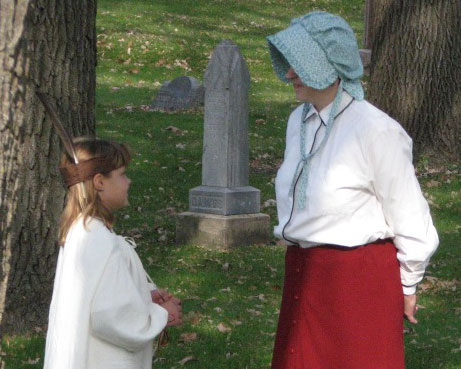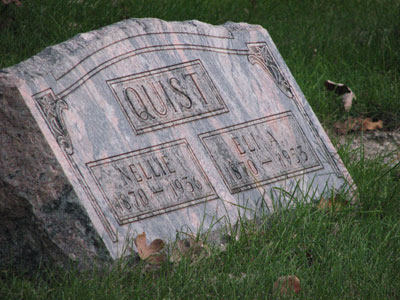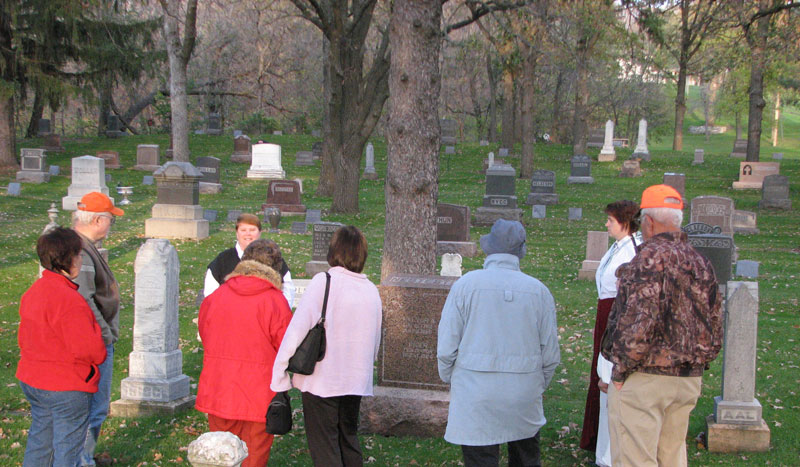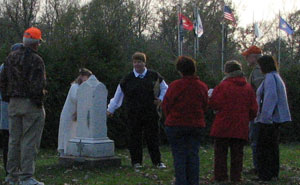

|
Merlin Peterson, director of the Pope County Historical Society and
Museum, approached me in January 2007 about creating a cemetery tour, a
follow-up to my October 2006 "Spookiest Spots in Pope County" bus
tour. We considered a series of soliloquies performed by actors stationed
at graves throughout the cemetery. But as I gathered material, I quickly
realized it would be better served by a guided tour where
participants, including the actors, could interact with each
other. The project took 6 months of research, a month of writing
(facilitated by the University of Minnesota AFSCME strike in September),
and about 3 weeks of meetings and rehearsals with the actors. It
was supported in part by a grant from the Lake Region Arts
Council. The tour was held in three shifts on October 13, 2007. Here are
some highlights. Rebecca Webb, October 2007. Tour photographs by Merlin Peterson. |

|

|

|
| The Cast: Bob Robards, member of the Glenwood American Legion Color Guard, appeared as himself to describe the horrors of fighting in the Spanish American War, Decoration Day practices at the French Cemetery, and his final memory of Nicky Koplos skating into the sunset. | 7-year-old Anna Vold portrayed Lillian Thorson, who died at one month in 1875 and may have the oldest grave in Glenwood Cemetery. We depicted Lillian as a child with a passion for Indian lore because her older sister, Alice Thorson, wrote The Tribes of Pezhekee. | Suzanne Vold portrayed Ingeborg (Rigg) Wollan, daughter of prominent founder and farmer Ole Rigg, but perhaps best known for her association with Emma Ferris, the unfortunate "little slave girl." |


|
"Can anyone name the oldest burying area in Pope County?"
It's a bit of a trick question. While many guess 'Old Yankee' or one of the graveyards associated with the earliest settlements to the south, Pope County has Indian mounds, which predate European cemeteries by centuries. |
|
Ingeborg's Indian story "My father was Ole Rigg Sr., a leading farmer in this area. I know, because it said so in a book published in Chicago called the Illustrated Album of Biography. He brought us to Pope County in the 1860s, when Indians still lived here. One of them, a little girl, used to come to our farm to play with my sister, Josephine. She wasn't as outgoing or well-cared for as we were, and you could tell she was a bit envious of the way we lived. But our mother always treated her as well as possible, the same as any other guest in our home." |  |
| Ingeborg eventually married Michael, known as M.A., one of the Wollan brothers. Before settling in Pope County, the Wollans worked in Missouri a while, near the Mississippi River. One day, they saw a slave plowing with a pair of oxen. When an ox got injured, the slave was brutally whipped for it. The Wollans never forgot. |

|
Before she married, while Michael was establishing the Fremad Association Cooperative Farmer's Store,
Ingeborg worked for the Peabodys at the Fountain House Hotel. "When the Peabodys came to Glenwood, they brought a little girl with them, not much older than you, a dark-skinned child named Emma. They were cruel to Emma, cruel like the people the Wollans saw in Missouri. I felt so sorry for her. Whenever I could, I tried to stand up for her, to protect her. But at Christmas time in 1870, I went home to our farm to visit my family. While I was away, Emma disappeared. I never saw her again." Emma's body was discovered the following April; she'd frozen to death in a slough. The theory was that she'd run away after a brutal beating, seeking refuge at the Rigg farm. She was buried, along with a threshing accident victim, but when the cemetery was created a few years later, nobody thought to move Emma. Ingeborg died in 1884. In 1902, Emma became one of those people accidentally disinterred during a building project. She was finally moved here...but no one marked the spot. Recently, Leland Peterson, a retired high school math teacher, applied divination techniques he'd learned from a Midwestern pastor to the area surrounding this little cross and asserts that a child Emma's age and size was buried here close to 1900. It's regrettable, that record-keeping was so spotty back then. But even today, for many Pope County burial grounds, the most up-to-date records are single copies of hand-written documents maintained in private homes. And sometimes the data on them conflicts with what gets typed up, or appears on the stones, or even legend itself. |
| Until the 1770s, the decorations on and around tombstones, such as skulls, reflected a certain fear of death. Angels became more common after that, demonstrating people's confidence that they would make their way to heaven. More recently, we see personal symbols, testimonies to individual attitudes about life and death, such as willow trees, hourglasses, or setting suns. At the Glenwood Cemetery Association Cemetery and adjoining Glenwood Lutheran Church Cemetery, we see a lot of flora and fauna, perhaps indicative of our affection for our pastoral setting. Richard Thompson put a remarkably accurate depiction of his lakeside cabin on his stone. We'll probably see more of that in the future. | ||

|

|

|
|
Bob Robards shared details about the Spanish American War beside the grave of Captain Edward Smith, who served in the Philippines for 18 months at the end of the 19th century. In 1898, Cuba wanted independence from Spain. The U.S. had interests in the area, and when riots broke out in Havana, we sent the U.S.S. Maine to Cuba. It was blown up, killing more than 250 men, and the U.S. went to war with Spain. The conflict lasted throughout the summer and ended with a U.S. victory. Spain, in accordance with the Treaty of Paris, ceded us Puerto Rico, Guam, and the Philippines for the sum of $20 million. So why was Edward Smith, a Todd County boy who would eventually make his living selling insurance in Pope County, stationed in the Philippines for 18 months? The Filipinos had been fighting Spain for their own independence since 1896. They didn't want to be our colony; they wanted to be free. So we went to war with them. It was a terrible war to have to fight in, full of atrocity and torture. American soldiers were accused of 'water cure,' torturing Filipinos by pouring water down their throats to make them feel like they were drowning. Filipinos buried Americans up to their necks in fire anthills. Back home in the U.S., the war was criticized as imperialism by noted figures like Mark Twain and in 1916, the U.S. granted the Filipinos self-rule. |

|
 "Maybe I've dreamed it since, but as I recall, the last time I saw Nicky, he was skating west into the sunset." Bob Robards George and Alexandra Koplos came to the U.S. as young adults. The Greeks were an oddity among their British and Scandinavian neighbors in Glenwood. But America was their country and they embraced it. They owned the Glenwood Candy Kitchen and Tip-Top Cafe, where you could enjoy lemon squashes and lime freezes, phosphates and cherry lemonade, 45 cent pork chops, 55 cent t-bones, or a nice ham and egg breakfast for less than half a dollar. Then, in 1928, tragedy struck. "The lake froze perfectly by the pavilion that year, as smooth as glass," recalls Bob Robards. "But as we skated west from shore, the ice began to pitch and heave beneath us. We younger kids headed back to the shallows, but the older boys just laughed and kept skating." Clarence Swanson and Harold Brundin heard the shot-like crack of the ice breaking. They raced to the where Nick had disappeard, but all they discovered was a cap floating in an open pool of water. Linemen from the railroad and volunteer firemen tried without success to rescue him. The Lutheran church where the Kooploses had worshipped and Nick had participated in Boy Scouts and the children's choir welcomed a Twin Cities minister of the Greek Orthodox faith into the sanctuary to preside over Nick's funeral. |
And now, a lingering mystery...

|

|
|
Behold the modest graves of Eli and Nellie Quist. In 1891, Eli's father, John P. Quist, was convicted of murdering an impoverished 50-year-old farmer, Lars Berglund, with a hatchet. The Quists and the Berglunds were neighbors, living on either side of the Northern Pacific Railroad, about 3 miles west of Glenwood. One day, John and his sons came along in a wagon and discovered Lars building a fence on his property to the north from a bountiful pile of abandoned railroad ties left on the right of way. Feeling equally entitled to the cast offs of the railroad company, John and his sons, Eli and Charlie, began loading some of the ties into their wagon. Lars did not approve. While the sons hauled the first load away, he began to argue with John. The sons returned to find him throwing rocks at their father. Still, old man Quist, a rather elderly 65 years old himself, would not yield. So Berglund threw a hatchet at him. In self-defense, perhaps, Quist picked up the hatchet and struck back, dealing Lars Berglund a blow to the head. The Quists took Lars home and fetched medical attention. It appeared the injured man would live. But 36 hours later, Lars was dead, leaving behind a new baby and a destitute family. Old man Quist was convicted and sent to prison. But five years later, M.A.Wollan presented a petition signed by myriad local citizens to none other than Governor Merrion himself and soon thereafter brought the overjoyed Quist back home. So where is he? Not here! No John. No Charlie. Just Eli and his wife. If John Quist is buried elsewhere in the county, the guide could find no record of it. It's possible he left town, starting over somewhere else with the $30 he earned during 5 years in prison. But what could compel him to do that at 70 years of age, in that difficult pioneering era, when his friends and neighbors from Glenwood had just secured his release and brought him home? Lars is buried at the site of his murder. His wife and unfortunate daughter, Kari, lie in the Glenwood Cemetery, but unlike other families, they are far apart, perhaps interred in pauper graves. And where are the other Berglund children? Only Jonas rests beside his mother. Did the others move away, enraged by the release of the man who killed their father? Why did the citizens of Glenwood seek the release of John Quist? Did they like him better than the Berglunds? The story certainly presents Lars Berglund as greedy, hostile and violent. But we only have the Quists' side of the story. Why was Quist convicted at all, if it was a clear cut case of self defense? Any why did he leave this town after its citizens went to such great lengths to secure his release? Maybe he left to protect a secret. An article in a Starbuck paper, written decades after the incident, speculates that perhaps John Quist took the fall for one of his sons, sacrificing himself to give his boy a future. Maybe M.A. Wollan suspected as much. Maybe that's why he worked so hard to secure John's release. Maybe this is the grave of the real killer. Eli died in 1953 at the age 82. A farmer and a dray line operator, he was praised for his worth ethic and described in his obituary as an unassuming man who never sought publicity. There's no mention of his father or his brother. | |

|
|
History is a mystery! Do you know the name of Glenwood's founder? If not, you'll never find his grave, for nothing about it
bears
witness to his
legacy. The latest trend in cemeteries is...green burials! Morticians earn their fees by freezing bodies rather than embalming them. Thus they are safe to place in simple pine boxes. But on the surface, cemeteries are already green, an oasis of grass and trees and wildlife in an area that might otherwise be used for urban/suburban development or agricultural cultivation. There is no need to do away with enduring marble markers or other items of beauty and grace. So donate a stone bench where folks can sit and reflect on the significance of local history. Provide a statue, that others may ponder its meaning. And put as much as you can afford on your headstone. It may be your best chance to instruct those who come after, your most effective opportunity to provide the clues they can follow to history's truth. |
| The sun is setting. It's time to go. Thanks again to the Lake Region Arts Council and remember, you can take a self-guided tour of the complete script by visiting the Pope County Historical Society and Museum. Contact Merlin Peterson for more details. |

|